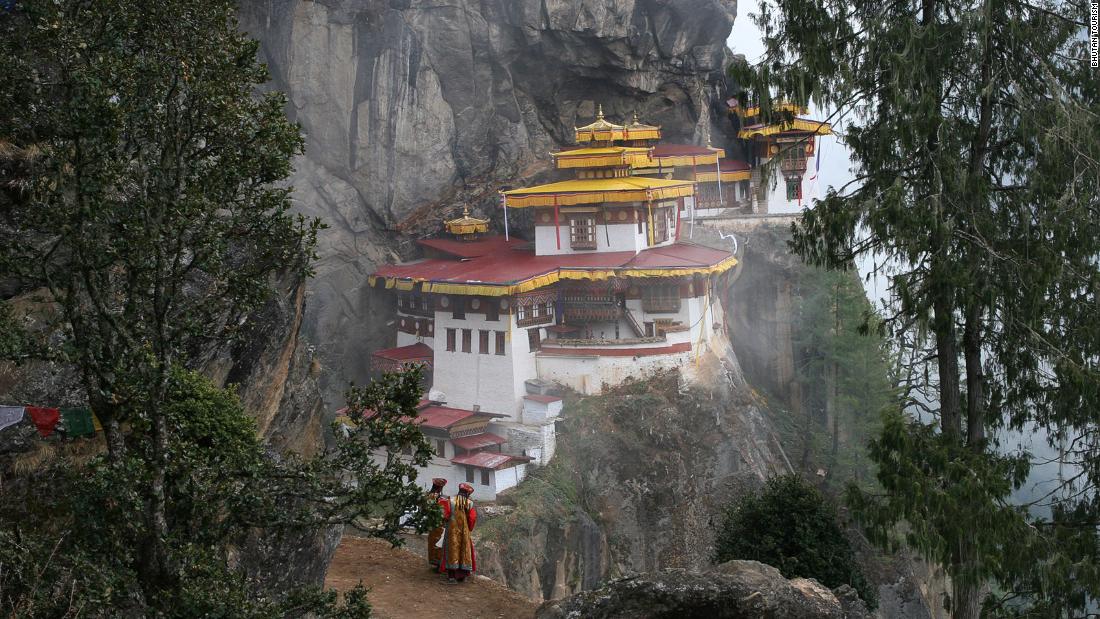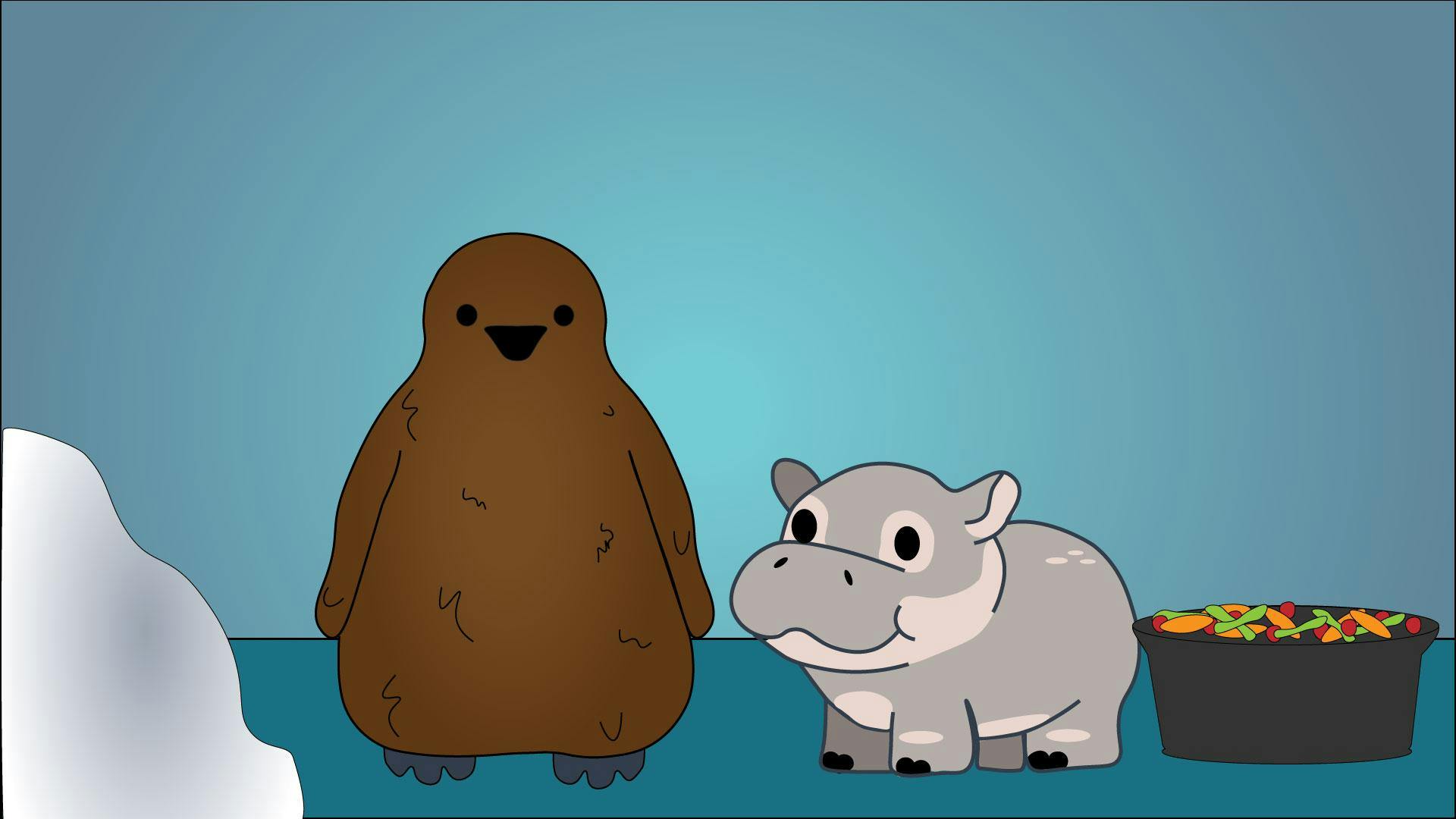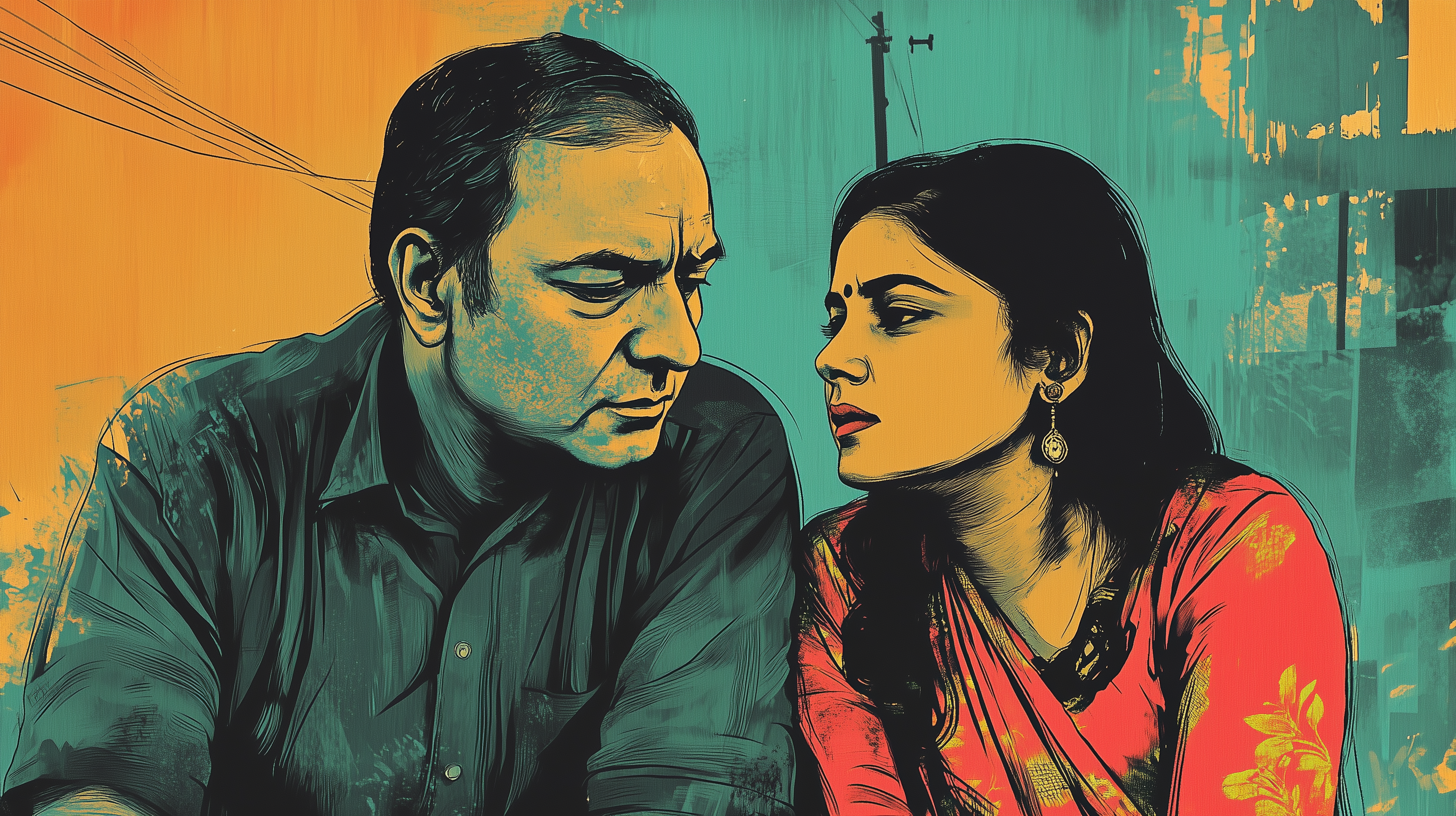It was that time of the year in 2019, when the people of a country dominated by lush green plains and inundated by countless crisscrossing rivers, feel a thrill far and wide. The thrill of witnessing something precious from their own homeland, the icy white ragged peaks of a Himalayan mountain – the Kanchenjunga. This mountain sends waves of emotion and excitement in the hearts of all nature lovers of Bangladesh, in the few weeks it decides to unveil itself to us. I was similarly touched by its beauty, even though I was a few hundred kilometres away, caught up in the busy city life of Dhaka unable to go watch the mountain, which added frustration to an already exhausted mind.
A tour to Bhutan was planned by my family at such a time, to which I promptly agreed to join. But I was wondering why it wasn’t cheering me up unlike other previous tours which would keep me flying in the clouds for weeks. But two days before our flight, as I was scrolling through the deluge of pictures of ‘Kanchenjunga from Panchagarh’ on Facebook, something clicked in my mind. I told myself, hang on, and even before the realisation got time to settle down, I ran to my father and said with an overjoyed voice that we could also see Kanchenjunga from our flight to Bhutan.
Two days later, our flight took off from Dhaka amidst the dense haze that perpetually haunts the city in winter. I got the seat on the left side of the plane, sat poised with my camera waiting to capture a shot. Slowly as we flew out of Dhaka, the haze cleared, the sky became blue, the Padma was glistening silver below us. I was anxiously trying to connect to Google Maps to locate our position but failed. With an anxiety that maybe we couldn’t see the mountain after all, I stared out through the oval window of the plane. Suddenly in the foggy distant, with the afternoon sun’s glare directly on my face, I spotted a jagged white line searing through the ceaseless blue of the sky.
It was Kanchenjunga welcoming us.
I was ignorant to not comprehend that what lay farther ahead was no less majestic than what I had just seen. As we entered Bhutan airspace and started our descent to Paro, the landscape was dramatically changed from plainland to incessant expanse of huge mountains. And they all appeared so close!! Which is obvious because Bhutan is 8,000 feet above the sea level on average. The more we descended, the more it felt like the plane was being engulfed by ‘waves of mountains’.
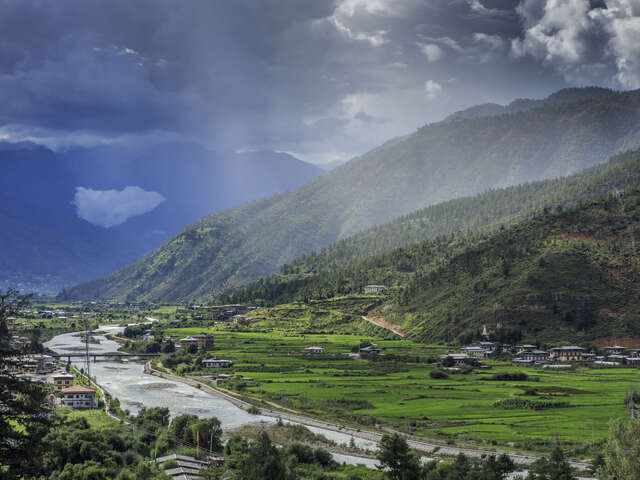
The plane landed in the valley of Paro, surrounded by gigantic green mountains on all sides. Three things that struck me the most as I got off the plane and stood on the tarmac was how extraordinarily beautiful the valley was, how bright the sunshine was and how blue the sky was. The decent humble Paro airport was immaculately designed in traditional Bhutanese architecture, every inch of its walls and pillars painted with bright colors depicting Bhutanese art and mythology – swirling dragons, odd creatures and unusually shaped humans.
As we boarded our bus from the airport and waited for it to start there was this unfathomable silence, for there wasn’t even a bird singing or a tree moving.
A silence so deep that as if the only thing creating a ripple was our own breathing and heartbeats.
Lunch was at a restaurant next to the airport, on the slope of an adjacent mountain overlooking the valley. The food was traditional Bhutanese soup, cheesy dishes and curry. We took our meal watching planes taking off, circling around the valley and flying off into the wilderness. Being an aviation enthusiast, this was yet another euphoric addition to my growing list of wondrous experiences.
We started our late afternoon bus journey to Thimphu via the Paro-Thimphu highway. The sun was already low and the shadows of the enormous mountains all around had already brought twilight to the valley below as we drove through the twisting, turning desolated highway, carved into the mountainside. The highway is so exceptionally well built in such a treacherous landscape that it is indeed a triumphant engineering feat. Throughout the entire length of the valley ran the mountainous river network which contributed so much to the beauty of Bhutan, at places like Punakha, Mo Chhu with its crystal clear blue water. The rivers are kept inaccessible to the public except at certain locations to keep them pure and pollution free. Bhutan’s commitment to nature and its efforts against pollution and carbon emission is something every country should idealize and follow.
Night had already fallen as our bus passed into Thimphu through a gate arching over the highway. The faint twinkling yellow city lights were like stars in the deep darkness of the night in the mountains. It was an unreal welcome, magical. Dinner at Druk Hotel was dishes of deliciously cooked fish caught from the mountain rivers, chicken with cheese cubes and butter rice.
The next day started with a drive back to Paro. That was a day of visiting different beautiful monasteries and museums with unique paintings adorning the marvellous architecture all over. The location of those monasteries set on the slopes of the mountains offered breathtaking views of the Paro valley in different light at different hours of the day. Unfortunately, because of limited time, the mountain trek to the iconic Tiger’s Nest monastery was not possible. So, to soothe the frustration a bit, I spent a good half hour watching it from the valley below, alternating between my eyes and binocular. The myths and legends of Bhutan, animatedly presented to us by our guide did add a mystic aura to our day.
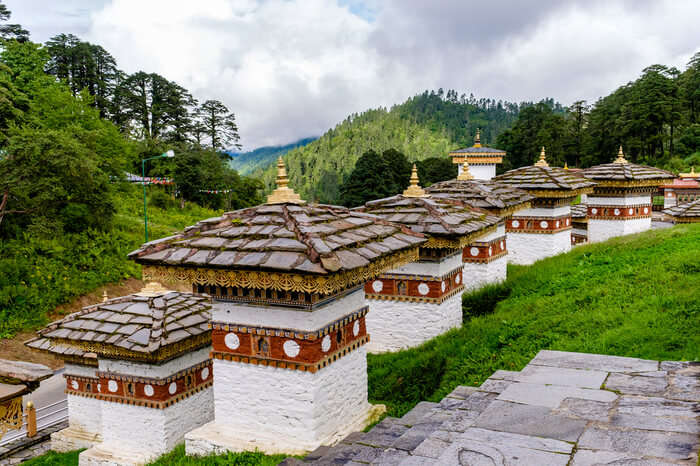
The following day was great fun as we joined all our family friends on the tour to travel to Dochula Pass, a mountain pass in the Himalayas within Bhutan located at an elevation of 10, 200 ft on the East West road from Thimphu to Punakha. Dochula Pass is the site of an iconic landmark comprising 108 memorial stupas built in memory of Bhutanese soldiers killed in a battle with Assamese rebels in 2003.
The road from Thimphu city to the Pass soon turns into a wild and treacherous highway. And the road only went up and up, winding and swirling around mountains. I sat in the front seat of the bus and the view was spectacular, bright green vegetation on one side along the mountain’s slope and a sheer drop to the valley on another side. Every few minutes, I kept checking our altitude in my watch’s altimeter. As the altitude went higher, the air pressure kept falling and my ears kept popping! Up and up the bus went through the precarious road.
Every minute there was a new sight to behold as more gargantuan mountains came into view.
The final leg of our journey had arrived. As I counted the moments, and as the air approached near zero temperature, the road became the steepest. Our bus was struggling to climb and with one last groan and cough it crossed the final precipice and came to a stop on the flat road at the top of the mountain, the first stretch of flat road that we passed in over an hour and a half.
The weather was absolutely clear, the sun shone to the brightest. And from Dochula Pass one could see, beyond rolling green hills and mountains, the Himalayas of Bhutan – a ceaseless stretch of snow clad icy mountains with clouds passing through them, called the Jigme Singye Wangchuk Himalayan range. It was a dream come true.
In clear weather of October to December, Dochula Pass provides stunning views of a number of Himalayan peaks including the highest of Bhutan; Gangkhar Peunsum, 7,570 metres high. Zongphu Gang, famously known as Table Mountain because of its flat top is a sight to behold. Probably the most artistic peak unveiled itself in an even more artistic way as I first caught sight of it through the branches of a lone tree on the Pass, the peak called Masang Gang (7,194 m high). The height and magnificence of the snow capped mountains made all other mountains look like dwarves. As I breathed in the chilly clear Himalayan air the elation felt at not just the beauty but also the simplicity of this little country and its people can only be interpreted as the Happiness of Bhutan.
Our flight next day was in the early morning. As we started from Thimphu in the chilly dawn, we could see patches of snow covering roadside trees and hill slopes here and there. It was particularly cold that morning, temperatures below zero degrees, as we arrived at Paro. Some hours later, just as our flight had ascended from the Paro valley, Kanchenjunga was there. This time rising proudly above a sea of clouds, in stark contrast to the scenery the day we arrived, back when the sky was crystal clear blue. As the plane cruised south towards Dhaka, the landscape below again changed from high hills to the ever familiar plain lands and rivers. But there was yet another marvel waiting. Beyond Kanchenjunga, far away in the west, there was another cluster of ragged white peaks breaking the clouds. There was only one other mountain in this region high enough to be visible above the clouds, which was in fact the highest mountain in the world, Mt Everest. In the few minutes it was visible, I was practically pacing up and down the plane to find an empty window seat from where I could get a shot of the Emperor. Luckily, I could.
Mt Everest was the first to disappear from view as we entered Bangladesh airspace. But the glorious Kanchenjunga was still there.
It became tinier by the minute, but it didn’t go out of sight. Only when the plane got engulfed by the fog of Dhaka, Kanchenjunga left us. It stood there, visible to us for a good 45 min of the one hour long flight, as if waving us goodbye, just as one’s loved ones keep on waving tirelessly, standing on the platform, as long as the train carrying one away is even faintly discernible. But maybe our loved ones keep on waving at us even after they lose sight of the trailing edge of the train carrying us. Who is to say that Kanchenjunga didn’t do the same for us as it watched our plane carry us into the unknown mist of lifeless aura that surrounds us in cities, an aura that we all yearn to break free from. Kanchenjunga waits for me, you and everyone…
